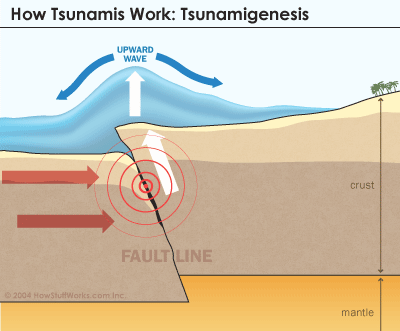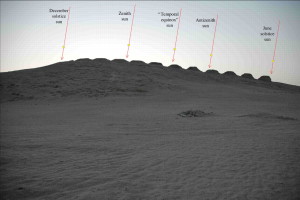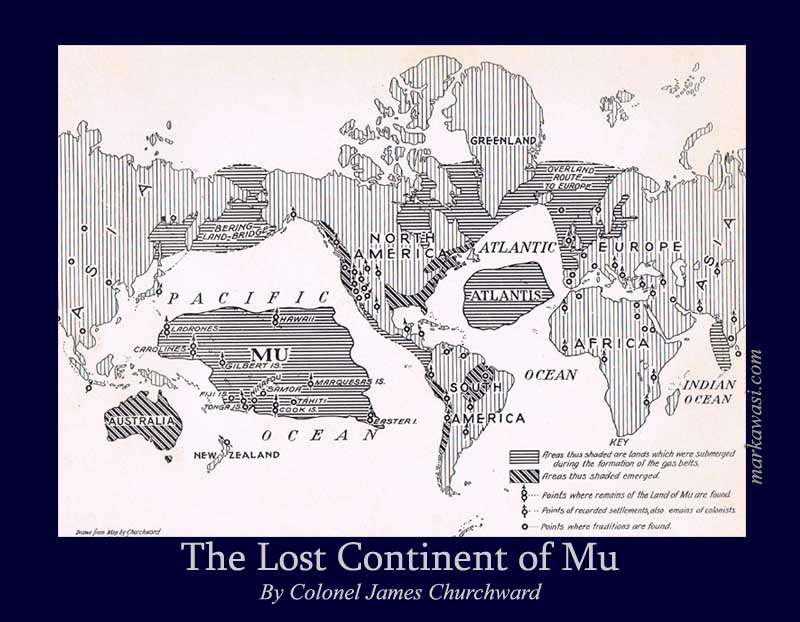Hawaii
Moore, Tom T.
Tom T. Moore is an American self-help author and self-declared telepath, who has written on a variety of  subjects including Atlantis and Lemuria(a). He conventionally places Atlantis in the Atlantic Ocean and Lemuria in the Pacific. According to Moore, Atlantis was destroyed by a natural disaster 31,000 years ago and again 12,500 years ago as a result of a war!
subjects including Atlantis and Lemuria(a). He conventionally places Atlantis in the Atlantic Ocean and Lemuria in the Pacific. According to Moore, Atlantis was destroyed by a natural disaster 31,000 years ago and again 12,500 years ago as a result of a war!
Lemuria was larger than Australia and was formerly connected to Japan and for thousands of years was an idyllic place with its inhabitants vacationing in Hawaii!
However, Lemuria, also known as Mu, destroyed itself in an atomic war 7,500 years ago.
This ‘male cow effluent’, is expanded on in his Atlantis & Lemuria: The Lost Continents Revealed [1556].
(a) Atlantis & Lemuria—Latitudes & Longitudes | Ancient Code (archive.org)*
Tsunami
A Tsunami was probably first described in the 5th century BC by Thucydides when he wrote “in my opinion, the cause of the phenomenon wa s this: where the earthquake was most violent, the sea receded and was then pushed back with even greater violence, thus bringing about a flood. Such a thing would not have happened without an earthquake” (Peloponnesian War, Book III.89)(b). However, there are also conditions that can produce tsunamis inland, such as occurred around 500 AD inundating Geneva in the Alps(k)(m).
s this: where the earthquake was most violent, the sea receded and was then pushed back with even greater violence, thus bringing about a flood. Such a thing would not have happened without an earthquake” (Peloponnesian War, Book III.89)(b). However, there are also conditions that can produce tsunamis inland, such as occurred around 500 AD inundating Geneva in the Alps(k)(m).
The word ‘tsunami’ first appeared in an English language publication in the September 1896 edition of National Geographic Magazine in which the devastation caused by an earthquake wave in Japan was graphically described.
Recent studies(g) indicate that a similar tsunami saved the Greek town of Nea Poteidaia from a Persian attack in 479 BC. Herodotus in reporting the event attributed the Persian defeat to divine intervention by Poseidon, god of the sea.
A similar event on an even greater scale has been one of the suggestions as the possible cause of the flooding of Atlantis. A 2002 paper(a), by Louisiana State University geologist, Gary Byerly and his team, identified an ancient asteroid impact that generated a tsunami that “swept around the earth several times, inundating everything except the mountains”. The study of ancient tsunamis is at a very early stage of development.
A 2019 report was published online in 2022 in which it was revealed that the Yucatan asteroid impact credited with wiping out the dinosaurs 65 million years ago generated mile-high tsunamis that travelled halfway around the world. One wave was estimated to have been 1.8 miles high(ae).
Ivan T. Sanderson in one of his books, Investigating the Unexplained [768], recounts an 1863 report of a 200-foot high tsunami that sped up the Ganges and Houghli Rivers in India killing tens of thousands of people without ‘snapping-off’ trees. He contrasts this with the tree stumps covering acres around East Creek, New Jersey that have all been broken off at the same height and where he suggested that only a tsunami could have caused such widespread and uniform destruction. In view of the fact that some of these cedar trees had six-foot diameter trunks, he speculates on the possible size of a tsunami that could bring about such extreme damage.
Perhaps even more relevant to the study of Atlantis is the evidence gathered by Jürgen Spanuth in his chapter on the ‘Natural Catastrophes of the 13th Century’ including an interesting section on tsunamis [015.167].
Marc-André Gutscher of the University of Western Brittany in Plouzané, France, has discovered evidence of an ancient tsunami on Spartel Island, an Atlantis candidate, in the Gulf of Cadiz. Georgeos Diaz-Montexano has pointed out that Josephus, the 1st-century Jewish historian, seems to describe the devastation caused by its assault on the Atlantic coast of Spain and Portugal at the time of the Lusitanians and Cantabrians in the 1st millennium BC.
>Some years ago, Richard Freund, a professor from the University of Hartford, expressed support for the Donana Marshes of Southern Spain as the location of Atlantis, he attributed the swamping of the locality and the submergence of Atlantis to the power of a tsunami(ah). In 2003, Werner Wickboldt claimed that following an examination of satellite photos of Doñana, he detected structures that very closely resemble those, which Plato described in Atlantis. Freund, claims to have led a team to study the area and has had work included in a March 2011 National Geographic documentary, Finding Atlantis. However, Spanish anthropologist Juan Villarias-Robles who has worked on the site for some years has declared that Freund did not lead the investigations on the site and in fact spent less than a week there. Wickboldt’s images turned out to be either smaller than expected or were from the Muslim period. Evidence for Atlantis (or Tartessos) has not been found there.<
In the late 1970s, Booth & Fitch suggested in Earthshock[1295] that tsunamis may have been responsible for the devastation of Atlantis, an idea that has gained in popularity.
Sergio Frau has postulated that the Atlantean civilisation on Sardinia was destroyed by a tsunami.
Professor Stefano Tinti of Bologna University visited Sardinia and explained(r) “that until the 1980s no one was aware that tidal waves had occurred in the Mediterranean. But since 2004 scientists have identified 350 events of this type over a 2,500-year period,” and regarding the Sardinian tsunami “So what would have been required in our case?” he then asked. “We’re talking about a huge volume of water, some 500 metres high [the elevation up to which the nuraghi were affected]. Only a comet could do that if the impact occurred very close to the coast and in a very specific direction,” he asserted. An event of this sort may have occurred near Cagliari, with the resulting wave devastating the plain of Campidano.”
Tinti has also noted(w) that generally speaking, the majority of tsunamis are generated by seismic rather than volcanic activity. Globally, volcanic tsunamis account for only 2% of the total, however, the profusion of volcanoes in Southern Italy has considerably increased this percentage. Furthermore, according to a recent article on the BBC website “The scale of the tsunami hazard from volcanoes that collapse into the sea has been underestimated.”(x)
A 2022 report of a recent study(ac) revealed some new interesting information.
“Archaeologists have found evidence of the largest known earthquake in human history — a terrifying magnitude-9.5 megaquake that caused a 5,000-mile-long (8,000 kilometres) tsunami and prompted human populations to abandon nearby coastlines for 1,000 years.
The earthquake struck about 3,800 years ago in what is now northern Chile when a tectonic plate rupture lifted the region’s coastline. The subsequent tsunami was so powerful, it created waves as high as 66 feet (20 meters) and travelled all the way to New Zealand, where it hurled car-size boulders hundreds of miles inland, the researchers found.”
More recently, Dhani Irwanto has written about the probable effect of tsunamis on his Indonesian Atlantis(y). Studies of the sedimentary record in a sea cave in Sumatra have revealed the frequency and strength of tsunamis in the region over a five-thousand-year span from 5900 BC until 900 BC(u).
Tsunamis are also associated with the destruction on Crete following the eruption of Thera in the 2nd millennium BC. A TV documentary entitled Sinking Atlantis(i), provided graphic evidence of tsunami damage on Minoan Crete(h).
J.V.Luce cited[120.119] a number of local legends from around the Aegean that may have originated with the tsunami that followed the eruption on Thera.
However, the extent of this damage is strongly contested by W. Sheppard Baird(j) and he proposes instead that it was in fact more likely to have been a pyroclastic surge from the Theran eruption that caused the most damage.
A recent report(d) concludes that a large tsunami generated by the volcanic activity of Mt. Etna around 6000 BC produced waves up to 43 feet high that struck the coasts of Greece and Libya. This event would have caused devastation on nearby Malta, where evidence of past tsunamis was published in the journal Zeitschrift für Geomorphologie. The research was carried out over three years by scientists from the University of Portsmouth, led by Dr Malcolm Bray with assistance from colleagues at the Department of Geography at the University of Malta(n). A 1693 earthquake generated the earliest recorded tsunami on Malta and as recent as 1908 Malta was hit by a tsunami that resulted from a catastrophic earthquake in the vicinity of the Strait of Messina(p).
On the Atlantic west coast of Ireland, we have a 250 km2 region, in County Clare, known as the Burren, which consists of limestone denuded of soil cover. Recently, strong evidence was discovered suggesting a 4000 BC tsunami in the region(o). For me, the karst landscape of the Burren is reminiscent of parts of Malta.
Plato’s description does not support the idea of a tsunami as the primary cause of Atlantis’ inundation since tsunamis will eventually subside and return to the ocean, whereas Atlantis was still underwater centuries after the event, causing a permanent navigation hazard. John Michael Greer makes a similar point [345.126] in relation to the megatsunami which struck Madagascar in 2800 BC. Evidence of other ancient megatsunamis in Hawaii was presented at the 2012 meeting of the American Geophysical Union(l). The power of megatsunamis is highlighted in an article on the UK’s MailOnline website(t). Atlantisforschung also offers a lengthy article about megatsunamis(af).
Recent excavations at Olympia on the Peloponnese peninsula, the location of the original Olympic Games, have pointed to the site having been repeatedly hit by devastating tsunamis during the past 7,000 years(c).
The Bunurong tribe in Australia has a ‘myth’ that explains the creation of Melbourne’s Port Philip Bay. A recent article(e) has linked this to a tsunami that resulted from the impact of Comet Manhuika southwest of New Zealand in the 15th century. A more cautious view of this event is expressed elsewhere(f).
The excellent livescience.com website has an interesting list of ten history-making tsunamis(q), while Wikipedia offers an extensive list of European tsunamis from prehistoric times until the present(s).
A 100-metre-high tsunami, caused by a landslide, one of the highest ever recorded was experienced in a remote area of Greenland in June 2017. Four lives were lost and eleven houses were destroyed in the fishing village of Nuugaatsiaq, located on an island about 20 kilometres away(v).
The Greenland event would have been greatly overshadowed, literally, by the tsunami generated by the asteroid that struck Mexico’s Yucatán Peninsula around 66 million years ago that killed off the dinosaurs. According to a 2021 report(z) it has been estimated that the impact produced a tsunami nearly a mile high!
In 2020, David Keys, author of Catastrophe [1330] wrote an article for the UK’s Independent newspaper outlining the most recent research into the 6200 BC tsunami that destroyed Doggerland. “It is estimated that multiple giant waves inundated some 2,700 square miles of land – from Scotland in the north to Norfolk in the south. New underwater research carried out by the universities of Bradford, Warwick, St Andrews and Wales has for the first time discovered that the tsunami devastated parts of East Anglia and adjacent land which is now submerged beneath the southern part of the North Sea.” (ab)
>However, 6200 BC would seem too early for the destruction of Plato’s Atlantis, apart from which the idea that at such an early date anyone living on Doggerland would have any knowledge of Athens or have the means or even a reason to invade a city 3,000km away (over 6,000km by sea). Even if they undertook such a venture, on arrival they would have to wait around for a couple of millennia before anything worth invading was developed there!<
Stuart L. Harris published a paper in 2020 entitled 5760 BC: tsunami at Rhine Valley caused by Planet X(ad). This was based on a translation of a long inscription written on a cliff face in Germany. Harris explains that in 5760 BC “satellites from a mysterious Planet X struck the continental shelf of Texas “that pushed a piece of the shelf the size of Massachusets into the Gulf. Above the displaced shelf, the sea towered 1.9 km high. The resulting tsunami dispersed in all directions and obliterated coastal communities around the North Atlantic.
In Germany, it surged over the Ruur Mountains west of the Rhine Valley, flooded the middle Rhine between Mainz and Karlsruhe, and continued over the eastern escarpment toward Heilbronn. It left extensive ripple marks in the Rhine Valley and the eastern plateau.” Harris offers some interesting data to support this claim.”
On August 12, 2021, within minutes of each other, two earthquakes struck the South Sandwich Islands of the South Atlantic. National Geographic reported “These rumblings, which occurred on August 12, 2021, were not unusual on their own, since the islands sit atop a combative meeting of tectonic plates. The odd part is that they were followed by a tsunami powerful enough to show up on distant shores along the Atlantic, Pacific, and Indian Oceans. Although the swell wasn’t destructive, it was the first since the catastrophic tsunami of 2004 to be recorded in three different oceans(aa).“
The Live Science website reported(ag) “On Jan. 15, 2022, the Hunga Tonga-Hunga Ha’apai submarine volcano — a large, cone-shaped mountain located near the islands of the Kingdom of Tonga in the South Pacific — erupted with a violent explosion. The eruption generated the highest-ever recorded volcanic plume, which reached 35 miles (57 kilometers) tall. The outburst triggered tsunamis as far away as the Caribbean, as well as atmospheric waves that traveled around the globe several times.” and “The Tonga underwater volcanic eruption rivaled the strength of the largest U.S. nuclear bomb and produced a “mega-tsunami” nearly the height of a 30-story skyscraper.”
(a) See: Archive 2931
(c) Olympia hypothesis: Tsunamis buried the cult site on the Peloponnese (archive.org)
(d) https://www.livescience.com/1170-towering-ancient-tsunami-devastated-mediterranean.html
(e) https://www.thunderbolts.info/wp/2012/02/10/mega-tsunamis-chinese-junks-and-port-phillip-bay/
(g) https://www.livescience.com/19809-ancient-wave-real-tsunami.html
(h) Sinking Atlantis | Full Episode | Secrets of the Dead | PBS (archive.org)
(i) https://video.pbs.org/video/1204753806/
(j) https://www.minoanatlantis.com/Sinking_Atlantis_Myth.php
(k) Tsunamis in the Alps? (archive.org)
(o) https://www.irishexaminer.com/ireland/6000-year-old-settlement-poses-tsunami-mystery-193230.html
(p) https://www.timesofmalta.com/articles/view/20050109/letters/tsunami-events-in-malta.102636 (link broken) *
(q) https://www.livescience.com/28296-tsunamis-that-changed-history.html
(r) https://www.theguardian.com/science/2015/aug/15/bronze-age-sardinia-archaeology-atlantis
(s) https://en.wikipedia.org/wiki/List_of_tsunamis_in_Europe
(u) 5,000-Year-Long Tsunami Record Found in Guano-Encrusted Sumatran Cave – Seeker (archive.org)
(v) https://www.nature.com/news/huge-landslide-triggered-rare-greenland-mega-tsunami-1.22374
(w) https://www.springer.com/gp/book/9780792323167
(x) https://www.bbc.com/news/science-environment-49568107
(y) https://atlantisjavasea.com/2015/08/31/earthquakes-and-tsunamis/
(z) Chicxulub Asteroid Impact Created a Giant Tsunami Nearly a Mile High | Mysterious Universe
(aa) Source of mysterious global tsunami found near Antarctica (nationalgeographic.com)
(ac) Scientists find evidence for biggest earthquake in human history | Live Science
(ad) https://www.migration-diffusion.info/article.php?id=771
(af) Mega-Tsunami – Atlantisforschung.de (atlantisforschung-de.translate.goog)
(ag) 1st mega-tsunami on record since antiquity was triggered by Tonga volcanic eruption | Live Science
(ah) Lost city of Atlantis, swamped by tsunami, may be found | Reuters *
Peru *
Peru has recently been shown to have been home to one of the oldest monument building cultures in South America. The valleys of the Norte Chico region have revealed cities with pyramids and other large ceremonial structures that have now pushed the date of the earliest buildings to the end of the 4th millennium BC. Dr Jose Oliver, who lectures in Latin American archaeology at University College London, has stated: “that by 3100 BC monumental buildings were already underway, not just at an isolated site but also across a whole region”. Such structures were being erected 400 years before the earliest Egyptian pyramids! The Sechin Bajo site is now (2017) being claimed(r) as having the oldest manmade structures in the Americas and having been dated to 3500 BC.
The prehistoric coastal city of Caral (3400 BC) has also revealed that quipus, the ancient South American ‘writing’ system, was in use there as early as 3000 BC. A cache of 25 well-preserved quipus was discovered in an ancient warehouse in Peru in June 2014(d). It may be worth noting that systems similar to the quipus have been identified in Hawaii and ancient China(q).
Philip Coppens gave an interesting overview of the Caral site(a). A 2016 report(j)(k) reveals further details of the level of technology achieved at Caral(o). Also near Caral is Aspero (3700-2500 BC), another large pre-ceramic site(p).
As early as the 16th century Agustín de Zárate identified Peruvian natives as originally having migrated from Atlantis. Ignatius Donnelly made a similar suggestion in a chapter of his book that he devoted to a description of Peru as an Atlantean colony (Pt.5 Chap.5).
In the late 1950s and the 1960s, Mrs Karola Siebert of Lima attempted to link her own finds and other discoveries of structures and inscriptions in Peru with Atlantis. In 1958, she claimed to have found evidence of an Atlantis based religious cult in the Manchay Valley of Peru(a). She published her findings in a 24-page booklet, Atlantis in Peru [0547].The rather tenuous links suggested by her were compounded with a high degree of supposition. A few years later James Bailey also opted for Peru as the site of Atlantis.
Brien Foerester has proposed that the amazing Sacsayhuamán site has an Atlantean connection!(u) At other locations in Peru, Foerester claims that pre-Incan high-quality structures are evidence of Atlantean influence, which can be seen in a number of videos on his website.
In 2004, Professor Robert Benfer unearthed a structure at the Buena Vista site in Peru that was named the ‘Temple of the Fox’. This 33-foot high Andean temple revealed the earliest known astronomical alignment and sculptures in the Americas(e).
Peru also offers another rarely discussed mystery, namely, a long band of holes, numbering thousands, in the Pisco Valley, which has led to much head-scratching among archaeologists(l).
Petroglyphs, dated between 3,500 and 4,000 years old and described as an ‘astronomical laboratory’, have been discovered in northern Peru and disclosed in July 2014 in Archaeology magazine(c).
The Peruvian Times have an extensive ongoing (2011) series(b) on the history and culture of Peru which is well worth a look.
The Smithsonian Magazine claims that Peru was home to the oldest calendar in the New World(g), as well as the oldest solar observatory in the Americas(f), which is credited to the 4th century BC, thirteen towers of Chankillo(h)(i)(t), which is now a listed UNESCO World Heritage Site.
It was announced in August 2016 that an intensive search from space of undiscovered archaeological sites, would begin with Peru(m)(n).
In June 2018, a report(s) from Miami University “chronicles the remarkable skill of ancient Peru’s cranial surgeons” and reveals that with over 800 ancient trepanned skulls, Peru has “more than the combined total number of prehistoric trepanned skulls found in the rest of the world.”
Also See: Cuzco
(a) https://www.philipcoppens.com/caral.html (offline Dec. 2017) (See Archive 2138)
(b) https://www.peruviantimes.com/23/history-of-peru-series-part-1-the-dawn-of-urbanization/6447/ Subsequent parts of this series are to be found in the History section of the Peruvian Times.
(d) https://www.seeker.com/rare-incan-calculators-found-in-peru-1768752683.html
(e) https://web.archive.org/web/20160410040543if_/http:/articles.latimes.com/2006/may/14/science/sci-observatory14 (in 2 parts)
(f) https://www.smithsonianmag.com/science-nature/return-of-the-sun-cult-152321532/?no-ist
(g) https://www.smithsonianmag.com/science-nature/the-new-worlds-oldest-calendar-152115988/
(h) https://news.bbc.co.uk/2/hi/science/nature/6408231.stm
(i) https://www.bbc.co.uk/news/science-environment-12619455
(l) See Archive 3009
(p) https://web.archive.org/web/20190108223937/https://www.arqueologiadelperu.com.ar/aspero.htm
(t) Ancient Calendars (joedubs.com)
(u) https://hiddenincatours.com/atlantis-evidence-at-sachsayhuaman-peru/
Mu *
Mu was first used (invented?) by Brasseur de Bourbourg in 1869 as the name given to a mythical continent that supposedly existed in the Pacific Ocean, according to an incorrect translation of the Codex Troano. At the end of the 19th century, this fictional continent was confusingly moved by Augustus le Plongeon into the Atlantic! Subsequently, le Plongeon’s friend ‘Colonel’ James Churchward moved Mu back to the Pacific in a 1931 book, The Lost Continent of Mu[233], in which he presented it as a kind of Pacific precursor to Atlantis. Churchward claimed that his work is based on inscriptions on the so-called Naacal tablets, which he was allegedly taught to translate by an Indian priest. Churchward is reputed to have devoted 50 years of his life searching for Mu. In 2011 a hoax claim that the Naacal tablets had been rediscovered did nothing but detract further from Churchward’s already dubious reputation(d).
A paper by Megan Wright on the fakearchaeology website offers further debunking of the probably imaginary Naacal Tablets(g).
Churchward was born in England but lived mainly in America. He wrote a book on fly-fishing in Maine and even more incongruously was granted a series of railroad-related U.S. patents. Although he liked to be addressed as Colonel no record of his military service has been found. He never identified the monastery where his priestly mentor lived nor has any monastery ever claimed to possess such tablets. Churchward never produced any evidence whatsoever that the tablets existed. His books cannot be treated as credible as they offer nothing but the outpourings of an over-fertile imagination. At the time of his death, in California, he had a number of additional books in preparation.
Churchward’s grandson, Jack E. Churchward, now has a website(a) devoted to his writings. It is not generally known that the father of modern Turkey, Kemal Ataturk, had Churchward’s book studied in the hope of confirming links between the Turkish people and ancient civilisations such as the Uighur (recently in the news), Maya and Aztec!
In 1969 the French hydrologist Louis-Claude Vincent (1906-1988) published two volumes on the origins of civilisation which he placed in Mu. This was probably the last major work based on the very questionable output of Churchward.
Later psychics embellished the already colourful writing of Churchward and pushed the story from fiction to farce.
Strictly speaking, Mu should not be confused with Lemuria, as the former is just an invention of Le Plongeon while the latter word was originally used as a geological term to describe a hypothetical submerged landmass in the Indian Ocean. Nevertheless, the two terms are now frequently used interchangeably. In an article in New Dawn Magazine, Brian Haughton notes the speculations of some who think that Australia was once part of a sunken Pacific continent(h). Furthermore, a third name, Pan, has also been used to describe a vast sunken continent in the Pacific.
Brien Foerster, the Canadian-reared writer, claims that the Hawaiian Islands are the remains of Mu(b), whereas Churchward considered them to be just a tiny part of his imaginary landmass.
Jason Colavito, following some hate mail from an over-excited Mu ‘believer’, has written an interesting article(c) on the history of Churchward’s lost continent.
Frank Joseph in his most recent offering[1535] has some really nonsensical ideas to offer regarding mythical Mu. He claims that 40,000 years ago “sudden sea-level rises triggered migration from Mu around. The Pacific motherlanders settle on a large, fertile island about 380 kilometers due west of the Straits of Gibraltar. There, the newcomers merge with the native Cro-Magnon inhabitants, resulting in a new, hybrid culture – Atlantis.” He offers no evidence to support any of this and fails to explain how his Mu was inundated, but the new Atlantic home was not.
He then jumps forward to 9600 BC and has Mu flooded once again, followed by another wave of migration to Atlantis. Unsurprisingly, it offers no evidence and no explanation why these migrants would bypass the more accessible continents of Asia, Africa and America and head for an island in the Atlantic, which would have been affected by the same sea-level rise that inundated Mu!
In July 2023, David Hatcher Childress published a lengthy review of the story of Mu on the Ancient Origins website(e). I suppose in keeping with the spirit of our time, recycling is to be encouraged.
Also have a look at an earlier article entitled The Lost Continent that Never Existed: Mu, was published(f).
(b) https://www.grahamhancock.com/phorum/read.php?f=1&i=296625&t=296429
(c) https://www.jasoncolavito.com/blog/today-in-hate-mail-muvians-of-the-world-unite
(d) See: Archive 3033
(f) https://www.todayifoundout.com/index.php/2016/07/history-lost-continent-never-existed-mu/




